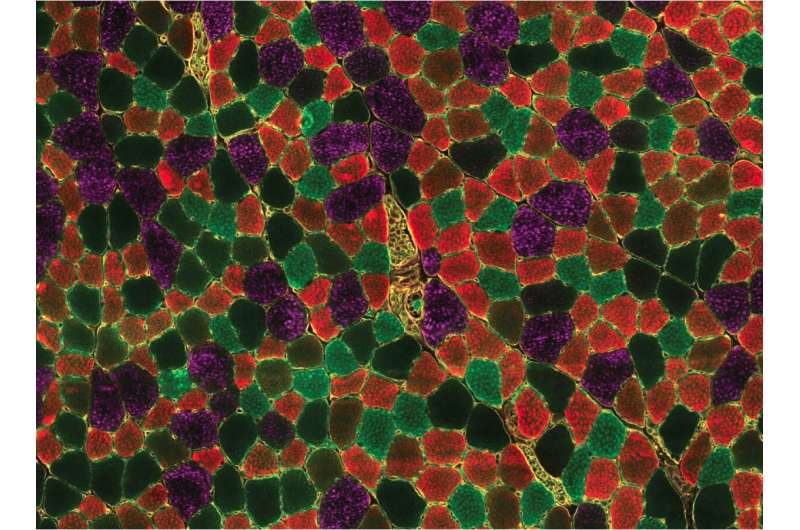Blocking sphingolipids counteracts muscular dystrophy

EPFL scientists have made the first link between muscular dystrophy and a group of bioactive fats, the sphingolipids, which are involved in numerous cell functions and other diseases.
In a new study, the group of Johan Auwerx at EPFL's School of Life Sciences has made the first connection between muscular dystrophy and sphingolipids, a group of bioactive lipids. The study is published in Science Advances.
Muscular dystrophy
Muscular dystrophy is an umbrella term for diseases where gene mutations result in progressive weakness and breakdown of skeletal muscles. About half of all muscular dystrophy cases involve Duchenne muscular dystrophy (DMD). DMD arises from a mutation of the gene that codes for dystrophin, a protein supports muscle structure by anchoring the cytoskeleton of muscle cells with their cytoplasm, the sarcolemma.
Mutations of dystrophin affect various biological pathways causing the hallmark symptoms of Duchenne muscular dystrophy: compromised cells membrane integrity, aberrant calcium homeostasis, chronic inflammation, fibrosis, and impaired tissue remodeling.
The sphingolipid connection
Discovered in 1870 and named after the famous Sphinx, sphingolipids are a group of bioactive lipids thought to be involved in cell signaling, and, surprisingly, many of the symptoms present in DMD. Therefore, the researchers asked whether the synthesis of sphingolipids can be altered in DMD—and if so, if they can be causally involved in the pathogenesis of DMD. To answer this, the researchers studied a mouse model of muscular dystrophy.
Blocking sphingolipids counteracts DMD
First, they found that mice with DMD show an accumulation of intermediates of sphingolipid biosynthesis. This was already a clue that sphingolipid metabolism is abnormally increased in the context of muscular dystrophy.
Next, the researchers used the compound myriocin to block one of the key enzymes of the sphingolipid de novo synthesis pathway. Blocking synthesis of sphingolipids counteracted the DMD-related loss of muscle function in the mice.
Digging deeper, the researchers found that myriocin stabilized the turnover of muscular calcium, and reversed fibrosis in the diaphragm and heart muscle. At the same time, blocking the synthesis of sphingolipids also reduced DMD-related inflammation in the muscles by moving the immune macrophage cells off their pro-inflammatory state and pushing them towards an anti-inflammatory one.
"Our study identifies inhibition of sphingolipid synthesis, targeting multiple pathogenetic pathways, simultaneously, as strong candidate for treatment of muscular dystrophies," write the authors.
Muscle aging and RNA
The study follows another paper on muscle aging by Auwerx's group, showing the effect of exercise on non-coding RNA genes in skeletal muscle. Exacerbated muscle aging leads to a disease called sarcopenia, which is characterized by markedly reduced muscle mass and muscle function in aged individuals. The EPFL researchers discovered the long noncoding RNA "CYTOR" and investigated its role in sarcopenic muscles of rodents, worms, and human cells. The study was published in Science Translational Medicine.
More information: Pirkka-Pekka Laurila et al, Inhibition of sphingolipid de novo synthesis counteracts muscular dystrophy, Science Advances (2022). DOI: 10.1126/sciadv.abh4423. www.science.org/doi/10.1126/sciadv.abh4423
Martin Wohlwend et al, The exercise-induced long noncoding RNA CYTOR promotes fast-twitch myogenesis in aging, Science Translational Medicine (2021). DOI: 10.1126/scitranslmed.abc7367

















